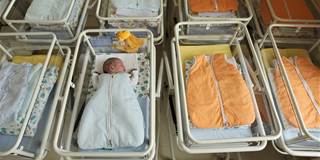The current downward trend in the US fertility rate would be troubling if strong growth and economic confidence required a larger workforce. But the evidence linking births with economic performance in developed countries doesn't add up, and America has nothing to worry about.
LONDON – News that the United States’ fertility rate fell in 2017 to 1.75 has provoked surprise and concern. A buoyant US economy in the 1990s and early 2000s was accompanied by fertility rates of 2.00-2.05 children per woman, up from 1.8-1.9 in the 1980s. But the increasingly strong economic recovery of the last five years has been accompanied by a declining birth rate. That seems to presage a long-term shortage of workers relative to retirees, and severe financial pressures on pension funds and health-care provision.
But the assumption that stronger growth and economic confidence must generate higher fertility – with low birth rates reflecting pessimism about the future – is not justified by the evidence. Moreover, fertility rates at around the current US level do not pose severe problems – and bring some benefits.
In all major developed economies, fertility rates fell during the 1960s and 70s, reaching levels below the replacement rate of around 2.05 children per woman. The US rate reached 1.77 in the late 1970s, compared to 1.8 in Northern Europe and 1.65 in Western Europe. And while we cannot be certain, the best expectation is that this shift to fertility rates significantly below the replacement rate will prove permanent, with temporary reversals driven by specific one-off factors.

LONDON – News that the United States’ fertility rate fell in 2017 to 1.75 has provoked surprise and concern. A buoyant US economy in the 1990s and early 2000s was accompanied by fertility rates of 2.00-2.05 children per woman, up from 1.8-1.9 in the 1980s. But the increasingly strong economic recovery of the last five years has been accompanied by a declining birth rate. That seems to presage a long-term shortage of workers relative to retirees, and severe financial pressures on pension funds and health-care provision.
But the assumption that stronger growth and economic confidence must generate higher fertility – with low birth rates reflecting pessimism about the future – is not justified by the evidence. Moreover, fertility rates at around the current US level do not pose severe problems – and bring some benefits.
In all major developed economies, fertility rates fell during the 1960s and 70s, reaching levels below the replacement rate of around 2.05 children per woman. The US rate reached 1.77 in the late 1970s, compared to 1.8 in Northern Europe and 1.65 in Western Europe. And while we cannot be certain, the best expectation is that this shift to fertility rates significantly below the replacement rate will prove permanent, with temporary reversals driven by specific one-off factors.